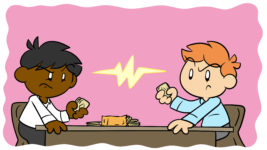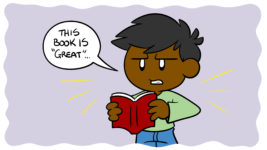If you’ve searched for writing advice recently, you’ve probably heard of MasterClass (not least because your search results are a prime resource for online marketing.) MasterClass boasts a lot of unique content, with some of the world’s most accomplished authors offering comprehensive lectures on their areas of expertise.
In today’s article, I’ll be looking at the MasterClass lectures of horror icon R.L. Stine, giving you a clearer idea of what you get for your money, what topics Stine chooses to cover, and hopefully providing a clearer idea of whether this is the course for you. Let’s begin, however, by talking about MasterClass itself.
What is MasterClass?
MasterClass is a learning platform that solicits and hosts unique classes from famous experts in a variety of fields, covering everything from writing (one of their most popular topics) to cooking, negotiating, and tennis. These larger classes are broken down into shorter lectures, usually lasting between two and twenty minutes, and can be watched directly on the site or downloaded to and watched via the MasterClass app (though not straight to a computer.)
Each lecture series is supported by an extensive practical workbook and access to The Hub, a social-discussion platform that promotes interaction with other MasterClass students. Some lectures (like Stine’s) offer additional resources, and most include some kind of digital interaction with the lecturer, though this tends to be minimal and only accessible to the first wave of people to take the class.
MasterClass series tend to hover around the four-hour mark, and Stine’s comes in at a respectable three hours and fifty-four minutes, with lessons that tend to take a little under or over ten minutes each.
Lecture series are available for purchase either individually, by lecturer, or via a timed all-access pass that opens up every lecture on the site. At time of writing, individual classes are $90 and the all-access pass is $180 for a year or $15 per month, with both also available as gifts that can be sent to other people.
Why R.L. Stine?
MasterClass’ main selling point is unprecedented access to huge names. The site boasts lectures by hugely popular authors such as James Patterson and Judy Blume, as well as critical darlings like Joyce Carol Oates and David Mamet. So, what does R.L. Stine bring to the table? Well, one of the best things about reviewing MasterClass lectures is that they’re really good at presenting this information for themselves.
Robert Lawrence Stine, better known as R.L. Stine, is one of the most recognized authors of children’s horror novels alive today. He’s been called “the Stephen King of children’s literature,” has penned more than 300 books for kids aged 7 to 15 years old.
… he has mastered the craft of simultaneously frightening and entertaining young readers. His prolific catalogue includes the popular Fear Street and Goosebumps series, and is widely appreciated by kids, parents, and teachers across the globe.
Over 400 million copies of his books have been sold worldwide, and they have been translated into 35 languages – making him one of the best-selling authors of all time. His Goosebumps TV show was the most popular children’s program in America for three consecutive years, and the Goosebumps movie (2015), starring Jack Black, became the #1 movie in the U.S. upon its release.
– R.L. Stine MasterClass Workbook
If you’re a grown-up, it’s probably been a while since you read something by R.L. Stine, but for a certain (pretty large) age demographic, the man’s a rock star, and unquestionably one of our most prolific modern authors.
The course’s official subtitle is ‘R.L. Stine teaches writing for young audiences,’ while the workbook says ‘the goal of this MasterClass is to provide you with all the tools you need to write a middle grade or young adult (YA) horror novel.’ The latter description is the more honest, and it’s worth pointing out the difference because there’s a repeated pattern of MasterClass asking a little more of authors than they have to offer. Ultimately, it’s in MasterClass’ interests to offer a definitive experience, but even the best author can only elucidate their own approach and thinking.
So, if you’re looking for a course on writing for young audiences, R.L. Stine does have things to tell you, but I’ll mainly be reviewing his lectures in the context of what he has to say about young horror, since that’s the topic Stine is both best qualified to cover and which he seems to be aiming to discuss. Titles like ‘Lesson 13: How to scare your readers’ (which itself includes the subsection ‘Make normal locations scary’) make the intentions behind this class clear, even if the advertising is a little more general.
The course
While R.L. Stine’s intended focus is young horror, it would perhaps be most accurate to describe this as a course on how R. L. Stine writes. Unsurprisingly, there’s a lot of value in hearing from such an accomplished author, but while many of Stine’s MasterClass contemporaries are philosophically-minded artistes, Stine is almost humorously workmanlike in his approach to the craft.
You don’t have to be afraid of writing. It’s not scary. Don’t listen to all these people who talk about how hard writing is; it’s not hard! … You can just write for fun. Why do you have to write from your heart? You know, the truth is, I’ve written maybe three hundred and thirty books, and I haven’t written a single one from my heart, not one.
– R.L. Stine, ‘Introduction’, MasterClass
While writers like Joyce Carol Oates and Margaret Atwood use their classes to distill their vast academic knowledge into a useful course, R.L. Stine offers a far more practical outlook, treating writing as a job that a person does for money. That’s not to say that Stine is some kind of charlatan – he clearly loves what he does and works to do it well – but he isn’t here to talk to you about the magic of writing. Instead, he focuses on the business of writing more than 300 very popular books.
I love the idea that people can turn to books just for entertainment, and nothing else. … People always says, “What are the morals you’re teaching?” There aren’t any. There are none. The main moral lesson is ‘run, run as fast as you can.’ That’s it. Because I don’t want that. Adults give themselves the right to read all kinds of trash, right? And adults can read entertaining magazines. But somehow they think, when it comes to kids reading, that the kids have to be elevated by what they read.
– R.L. Stine, ‘Lesson 8: Kids are the best audience’, MasterClass
In this vein, Stine talks about a lot of tricks and tips – he advises, for example, that authors end every chapter on a cliffhanger, since it’ll force the reader to keep reading. He says he’s been complimented on writing ‘amazing cardboard characters’ (characters who are all surface but get away with it) and when he offers the reader a list of twenty potential story ideas, he comments that he likes one of them so much that he’s written it three different times.
It’s the type of outlook that doesn’t dig very deep but offers up a lot of simple advice. Stine keeps up with his characters via ‘cheat sheets’ of their basic information, and he writes in the first person because it makes for scarier moment-by-moment writing.
“And at the end of her grey, bony arms were Lauren’s gloves.” And to me, that’s not as good, it’s not as scary, as saying, “And at the end of her grey, bony arms were MY gloves.”
– R.L. Stine, ‘Lesson 10: The key to scary writing: POV’, MasterClass
If R.L. Stine is your only source of writing advice, this is something of a problem, since meaningful writing tends to require you to look a little deeper. In ‘Lesson 14: Making monsters’, Stine is surprised that readers tend to declare his ventriloquist dummy character, Slappy, his scariest creation, shrugging off any investigation into why this might be the case. That’s the type of thing you’d expect a horror writer to explore when explaining his craft, but then he offers a piece of perfect practical advice like ‘Kids like to read about kids who are a little bit older than them. NOT younger’ or not to use current slang or technology because it will age the book too quickly, and suddenly it’s a question of whether it’s perhaps worth losing the deeper insight to gain genuine industry know-how.
That’s not to say that Stine has no deeper insight; he may not dig much into the craft behind his writing, but he does like and understand his audience. In ‘Lesson 9: Writing for different age levels’, he breaks down the difference between middle-grade readers, who aren’t ready for real-life violence or threat, and young-adult readers, who need real-life violence or threat to engage with horror. That’s the kind of no-nonsense insight that it could take you years to figure out on your own, but to Stine it’s obvious, and he delivers this lesson like a plumber pointing out why he’s fitting a particular type of pipe.
In short, R.L. Stine is a commercial writer, and that’s the bulk of what he’s able to teach. This isn’t a quality we tend to admire in artists, but in the context of MasterClass’ wider offering, it’s actually something special. Stine knows exactly what kind of author he is and, as he points out, it’s a conscious choice that’s made him very successful.
I wanted to be a commercial writer. And I think you have to figure out whether you want to do that kind of thing or if you have literary ambitions, and you want to write something that’s more for yourself than an audience. … [Ken Follett] was having a phone conversation with another author, a very literary author, very artistic, very serious author. And the author said to Ken, “I only write for myself. I don’t write for the audience. I only want to please one person; that’s me. And when I write, I write everything just for me.” And Ken said, “Well, that’s why you are a great writer and I’m rich.”
– R.L. Stine, ‘Lesson 23: Writing as a career’, MasterClass
As is to be expected, Stine also includes some of the usual advice that authors should give (because it’s good) but which can’t set them apart (because they all give it.) Here, too, Stine’s spin is that of a commercial author, and this renders some of his advice more helpful, since he’s not just explaining principles, he’s giving concrete instruction.
I set a goal for myself every morning, “Today I’m going to write 2500 words.” And then I don’t get up ’til I’m done. … And when I hit my 2000 words, I quit. Doesn’t matter where I am, where I am in the story I hit 2000 words, I quit. It’s kind of a trick that I use, because it makes it so much easier to start up again the next day. I haven’t finished a chapter, I’m not at the end of a chapter, I’m in the middle of something, so when I sit down the next day, I don’t have to start all over again. I don’t have to do much thinking; I’m in the middle of something already.
– R.L. Stine, ‘Lesson 25: Combating writer’s block and developing routines’, MasterClass
There’s little of this type of instruction that you can’t find elsewhere, but it’s possible that Stine’s delivery is what will finally make the typical good advice feel actionable, and he has a few moments of fresh delivery, such as when he talks about going to the Idea Store, which has three departments: ‘Experience, Memory, and Imagination.’
Of course, a particular method of delivery is a double-edged sword, and while Stine’s approach is what some authors will need to hear, it could alienate others. If, for example, you’re a fan of Joyce Carol Oates’ academic class or Margaret Atwood’s breakneck philosophical reflection on writing (both of which we’ll be reviewing soon), you may find that Stine’s lectures conflict with approaches that speak more earnestly to your own style. Of course, it might be that such conflict provides a mixed viewpoint that’s also worth considering.
A lot of authors, in interviews, they always say, “I wait for my characters to tell me what to do.” I always think that’s garbage, it’s ridiculous.
– R.L. Stine, ‘Lesson 4: Getting from idea to plot outline’, MasterClass
The extras
I’ve said in the past that the workbooks which accompany MasterClass lectures aren’t really worth considering when evaluating the classes. The lecturers tend to have almost no input in the workbooks, which has led to end products that talk around the information you’ve already heard from the horse’s mouth. While it’s useful to learn practically – to add exercises to the theory of a lecture – the person writing the exercises is working with exactly the same insight you just got, which tends to lead to supporting content that feels divorced from the whole point of the course; access to an expert.
By this standard, Stine’s workbook actually isn’t so bad. While it pulls the usual MasterClass trick of stylish presentation that also happens to triple the page count, it does outline a specific project that it keeps coming back to throughout the course.
Your assignment is to develop an idea for a story, assemble an outline, a character cheat sheet, and a first draft of your own (which will need to be revised at least once). All of the exercises comprising the Class Project will be labeled as such. You will also be asked to complete a variety of other exercises intended to improve your skills as a writer and storyteller.
– R.L. Stine MasterClass Workbook
This isn’t unique, but it does complement Stine’s all-business approach in a way that’s more likely to leave you with something useful at the end of the course.
Effort has also been taken to assemble a host of recommended texts and relevant articles that really do build on Stine’s teaching, although with no meaningful feedback, some exercises are good ideas that fall apart without assessment. If you did everything in the workbook, it would turn Stine’s four hours of lectures into a much, much longer course, but you’d also be expected to spend much, much more money for the necessary reading material.
On top of that, the workbook includes some shamelessly poor moments. Perhaps the worst is ‘Ask questions, and write down your answers. If your story has a superhero, ask, “what kind of powers does he have?”’ – an instruction which even the most neophyte author can surely work out for themselves. For all the thought put into suitable supplementary reading, sometimes the surrounding support is so minimal as to amount to little more than ‘read this book, it’s good.’ The extracts below haven’t been taken from larger exercises that help the reader unpack their intent; they’re the whole instruction.
Watch The Usual Suspects (1995), a film famous for its shocking final reveal.
– R.L. Stine MasterClass Workbook
Bob cites crime author Robert Crais’s ability to switch from first to third person in his police novels. Read The Forgotten Man. Do you find this technique distracting?
– R.L. Stine MasterClass Workbook
One of Bob’s favorite authors is British humorist P.G. Wodehouse, who wrote 92 novels which all took place in the same fictional world. Take a look at Thank You, Jeeves. Why do you think Bob was so drawn to this series?
– R.L. Stine MasterClass Workbook
Of course, you can discuss these exercises in The Hub, where they might grow in the sharing, but if MasterClass are willing to fork out for R.L. Stine based on his expertise, it’s not unreasonable that they solicit similar (though obviously less famous) talent for their workbooks.
Stine’s workbook is better than some that have come before, but this is still an area where MasterClass settles for something that comments on the course rather than something which elevates it. For any other writing course, textbooks or workbooks that didn’t meaningfully add to the lecture content would be bizarre. MasterClass workbooks continue to function as free extras that come with your purchase of the lecture series, rather than an asset that should be considered in your purchase.
The official workbook isn’t the only supplemental material available for Stine’s lectures, and his is the MasterClass writing series which offers some of the most beneficial supplementary materials: examples of his character cheat sheets and two outlines of his book I Am Slappy’s Evil Twin, one of which is the rejected original and one of which is the revised, accepted pitch, a process which he describes in ‘Lesson 7: Outline case study’. Stine ends his lecture with twenty story ideas for the viewer to try, pointing out that each is a potent idea that you could write in a hundred different ways. It’s a formulaic way to look at fiction, but in the context of Stine’s career, it’s a formula that works.
Is R.L. Stine’s MasterClass worth your time and money?
I said I’d primarily be reviewing R.L. Stine’s MasterClass as it pertains to writing horror for a young audience. If that’s your focus, go buy it now – Stine is an unparalleled expert in this field, and you should absolutely hear his advice, even if he doesn’t dig that deep.
Similarly, if what you want more than anything is to be a commercial author, it’s worth your money to hear Stine’s advice and, more than that, to soak up his outlook and attitude. A lot of successful commercial authors have pretensions of something greater, but from the very first moment where he insists he’s never written a book from the heart, Stine owns his outlook and can teach you to do the same, if only by example.
What about everyone else? Well, if you want to write horror for a general audience, Stine probably doesn’t have much to teach you. His instincts are unquestionably excellent, but as with the logic behind why readers fear Slappy, he’s not interested in exploring them.
If you’re interested in writing something other than horror but for the same audience, Stine again probably isn’t offering anything you need. You’ll get some commentary on what it’s like to be a beloved author of youth-skewing fiction, but that’s about it. Try Judy Blume instead.
Finally, if you’re a writer just looking for insight, it’s not worth buying Stine’s class on its own. He’s pleasant company, but there are moments where it feels like he’s lecturing because he’s been asked to do so rather than because he has four hours’ worth of wisdom to share. That said, hearing a commercial author being completely upfront about the thinking behind their career does have value. If you already have an all-access MasterClass pass, it’s definitely worth checking out Stine’s lectures, and I’d even suggest that if there are two other classes that you really want to check out, bundling in Stine’s class would be enough to justify the cost of subscription.
There’s a degree of ‘seeing how the sausage gets made’ to Stine’s class, and while that alone isn’t enough for the price tag, his viewpoint does pair well with many of the denser, more philosophical authors on the platform. It’s enlightening to hear Joyce Carol Oates talk about authors existing on ‘the marginal plane,’ but following that up with R.L. Stine’s workmanlike approach could help keep your feet on the ground. After all, he’s right: if you write a bunch of books that people really enjoy, you’ll be a successful (and probably pretty satisfied) author.
Have you tried R.L. Stine’s MasterClass? Do you have concerns about the service that aren’t covered in this review? Share your questions and experiences in the comments and if Stine doesn’t sound right for you but you’re still interested in MasterClass, check out our reviews of some of the other courses available:





